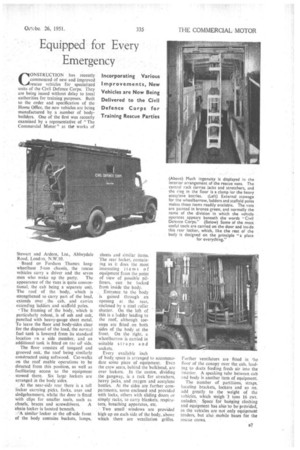Equipped for Every Emergency
Page 41

If you've noticed an error in this article please click here to report it so we can fix it.
Incorporating Various Improvements, New Vehicles are Now Being Delivered to the Civil Defence Corps for Training Rescue Parties
CONSTRUCTION has recently commenced of new and improved rescue vehicles for specialized units of the Civil Defence Corps, They are being issued without delay to local authorities for training purposes. Built to the order and specification of the Home Office, the new vehicles arc being manufactured by a number of bodybuilders. One of the first was recently examined by a representative of "The Commercial Motor" at the works of Stewart and Ardern, Ltd., Abbeydale Road, London, N.W.10.
Based on Fordson Thames longwheelbase 5-ton chassis, the rescue vehicles carry a driver and the seven men who make up the party. The appearance of the vans is quite conventional, the cab being a separate unit, The roof of the body, which is strengthened to carry part of the load, extends over the cab, and carries extending ladders and scaffold poles. • The framing of the body, which is particularly robust, is of ash and oak, panelled with heavy-gauge sheet metal. To leave the floor and body-sides clear for the disposal of the load, the normal fuel tank is lowered from its standard location cm a side member, and an additional tank is fitted on the off side.
The floor consists of tongued and grooved oak, the roof being similarly constructed using softwood. Cat-walks on the roof enable operations to be directed from this position, as well as facilitating access to the equipment stowed there. Six large lockers are arranged in the body sides.
At the near-side rear there is a tall locker carrying picks, forks, axes and sledgehammers, whilst the door is fitted with clips for smaller tools, such as chisels, braces and screwdrivers. A chain locker is located beneath.
similarlocker at the off-side front of the body contains buckets, lamps,
sheets and similar items. The rear locker, containing as it does the most interesting it ems of equipment from the point of view of possible pilferers, can be locked from inside the body.
Entrance to the body is gained through an opening at the rear, enclosed by a steel roller shutter. On the left of this is a ladder leading to the roof, although toesteps are fitted . on both sides of the body at the front. On the right, a wheelbarrow is carried in suitable straps and sockets.
Every available inch of body space is arranged to accommodate some piece of equipment. Even the crew seats, behind the bulkhead, are over lockers. In the centre, dividing the gangway, is a rack for stretchers, heavy jacks, and oxygen and acetylene bottles. At the sides are further compartments, some enclosed and provided with locks, others with sliding doors or simply racks, to carry blankets, respirators, breathing apparatus, etc.
Two small windows are provided high up on each side of the body, above which there are ventilation grilles.
Further ventilators are fitted in the floor of the canopy over the cab, leading to ducts feeding fresh air into the interior. A speaking tube between cab and body is another item of equipment.
The number of partitions, straps, locating brackets, lockers and so on, add greatly to the weight of the vehicles, which weigh 3 tons 16 cwt. unladen: Space for hanging clothing and equipment has also to be' provided, as the vehicles are not only equipment tenders, but also mobile bases for the rescue crews.




















































































